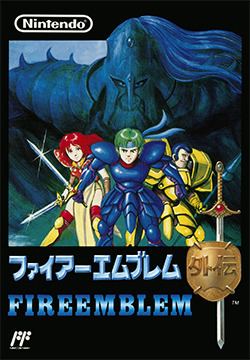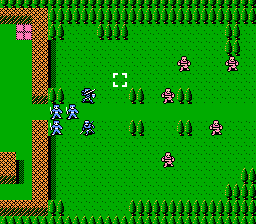Initial release date 14 March 1992 | ||
 | ||
Artist(s) Naotaka OhnishiSatoshi MachidaToshitaka Muramatsu Genre(s) Tactical role-playing game Platform Nintendo Entertainment System Similar Fire Emblem games, Intelligent Systems games, Tactical role-playing games | ||
Fire Emblem Echoes Gaiden is a tactical role-playing game developed by Intelligent Systems and published by Nintendo for the Famicom. Released in March 1992, it is the second installment in the Fire Emblem series, and the last to be developed for the Famicom. It builds upon the basic turn-based strategy gameplay of the previous title, while including new elements such as a navigable overworld. Set in the same world as its predecessor, Fire Emblem: Shadow Dragon and the Blade of Light, Gaiden follows the battles of two opposing armies on the continent of Valentia, which is torn apart by political strife involving the princess Celica and her adopted sibling and childhood friend, Alm.
Contents

The development began after the commercial success of Shadow Dragon and the Blade of Light: original designer and writer Shouzou Kaga returned and assumed the role of director, while Yuka Tsujiyoko and Gunpei Yokoi returned respectively as composer and producer. Kaga's main concern was addressing pacing issues from the first game, and allowing for a greater connection between players and the characters. The game was a commercial success, selling over 324,000 units as of 2002. It received mixed critical reception and was later compared to Zelda II: The Adventure of Link in its short-lived innovations. Some elements would be used in later Fire Emblem titles. A full remake, titled Fire Emblem Echoes: Shadows of Valentia, is set for a worldwide release on the Nintendo 3DS in 2017.

Gameplay

Fire Emblem Gaiden is a tactical role-playing game set on the continent of Valentia. Players take the role of adopted siblings Alm and Celica, navigating an overworld and having the ability to visit towns where the player may talk to traders to transfer items to the different group or find new units. The overworld is freely navigable, with further areas opening up as the story progresses. The game features two difficulty levels: "Normal" and "Easy". On Easy mode, experience points earned through actions in combat are increased, and items can be exchanged between units beyond vendor stalls.

Battles use a turn-based battle system, with player, enemies, and sometimes non-playable characters each taking turns and moving across a grid-based battlefield: battles are won by the player defeating all enemies in a map or killing a boss character. Enemies include human troops and monsters. The players are given a limited number of units, which are each assigned unique character classes that have various functions in battle, such as being mounted or having access to magic. A unit's class also affects their range of movement on the battlefield. In contrast to the previous game, character classes are not set, but can switch once a character reaches a certain level. A special example of class promotion is the two main characters: Alm can promote from a Fighter to a Hero, while Celica promotes from a Priestess to a Princess. Each time a unit raises its experience level, its various stats increase based on a percent chance unique for each character. Spells for magical classes are learned through leveling up rather than being part of a separate system, and each spell consumes part of the caster's health when used.
Synopsis
The continent of Valentia was once divided between the Earth Goddess Mila and the Dark God Duma, siblings who split up and formed rival nations devoted to worshiping them: Mila's nation of Zofia, and Duma's nation of Rigel. The two deities, who each held extreme viewpoints on the world, ended up corrupting their subjects, and Zofia was eventually swallowed in a war triggered when its military leader, General Desaix, attempted a coup d'état. Rigel's ruler King Rudolf used this opportunity to lead Rigel's armies across Valentia in an attempt to destroy both deities. The game follows two protagonists, lifelong friends and adopted siblings Alm and Celica, as they lead armies on opposing sides of the conflict. Over the course of the game, it is revealed to Alm that he is the hidden prince of Rigel, whereas Celica is both the princess of Zofia and a priestess of the goddess Mila. Despite having different goals, the two join forces and fight back against both Desaix and Rudolf. They then find the vanished Mila and launch a final assault on Duma. With Duma's defeat, both deities disappear from the world. Alm and Celica marry and unite Valentia under their rule.
Development and release
The development began following the commercial success of Fire Emblem: Shadow Dragon and the Blade of Light in 1990. The original game's designer and writer Shouzou Kaga returned to those roles and also became director. In addition to Kaga, Gunpei Yokoi returned from Shadow Dragon and the Blade of Light as the game's producer, while the visuals were created by Naotaka Ohnishi, Satoshi Machida and Toshitaka Muramatsu. The music and sound design was handled by Yuka Tsujiyoko, who had worked on the first Fire Emblem. The game's title, "Gaiden", is a Japanese term for a side story related to a larger work, denoting the game's status as a secondary adventure set in the same timeline as the first game.
Kaga designed Gaiden to address issues raised with the first game, such as tedious elements of map navigation. The system of Shadow Dragon and the Blade of Light was used as base for various improvements to aspects such as enemy AI, although the gameplay adjustments ended up removing some of the strategic elements. These elements included a navigable overworld and more overt role-playing elements, along with the introduction of the class evolution system. Balancing these elements proved challenging for the team. The game made use of the new MMC4 memory chip, developed partially in response to the memory capacity problems faced during the development of the first game. For the story, Kaga wanted to deepen the relationship between the player and their units, represented through the growth of the characters through their battles. To create a stronger and broader central narrative, Kaga created the game's dual protagonists. An overt reference to Shadow Dragon and the Blade of Light was made in the form of a trio of female Pegasus Knights, who were similar to another trio from the first game yet bore different names.
Gaiden was released on the Famicom on March 14, 1992. It released on a 2Mbit cartridge. It was the second and last game in the series to be developed for the system, and has never received an official release outside Japan. It would later receive multiple releases on Nintendo's digital Virtual Console platform: the version for the Wii released on November 4, 2009, the version for the Nintendo 3DS on April 3, 2013, and the version for the Wii U on August 20, 2014.
Reception and legacy
As of 2002, Gaiden had sold 324,699 units. This made Gaiden the fourth best-selling title in the Fire Emblem series to that date. Video game magazine Famitsu gave Gaiden a score of 28 out of 40. In their review, critics noted that its gameplay changes meant that it could not be compared to its predecessor, with one critic enjoying its gameplay and calling it better than the first game. Another critic noted that it was fairly easy during the first half, then became rapidly more difficult during the later stages. Another reviewer noted that, while the number of maps had increased, the strategic elements had become noticeably weaker. Fan reception was positive: in a poll taken by Family Computer Magazine, it received a score of 24.3 out of 30, indicating a large popular following. In a later retrospective article on the Fire Emblem series, Pocket Gamer's Mark Brown compared Gaiden's radical and short-lived shift in gameplay to that of Zelda II: The Adventure of Link. Nadia Oxford of USGamer also compared Gaiden to Zelda II due to its shortlived gameplay changes, in addition to the similar case of Castlevania II: Simon's Quest.
While the majority of Gaiden's new gameplay elements would be discarded in later entries, the concept of class evolution was retained throughout following entries. The concept of a navigable overworld map and towns the player could visit was later explored in the Game Boy Advance entry Fire Emblem: The Sacred Stones in 2005. The story concept of the returning Pegasus Knights from Shadow Dragon and the Blade of Light was also revisited in the Nintendo 3DS title Fire Emblem Fates in 2015, with the inclusion of characters from its 2012 predecessor Fire Emblem Awakening. A full remake for the 3DS, titled Fire Emblem Echoes: Shadows of Valentia, is set for worldwide release in 2017, marking the game's debut in the West.
